An enormous supermassive black hole has been spotted bursting into action around 10 billion light years away.
The huge black hole spat out a gigantic flare of energy, which was named J221951-484240, or J221951, and is one of the most luminous objects rapidly changing brightness—known as transients—ever recorded.
The finding was revealed by Samantha Oates, an astronomer at the University of Birmingham in England, at the U.K.'s annual National Astronomy Meeting on Tuesday. A paper describing the discovery is currently available on preprint server arXiv, and will soon be published in the journal Monthly Notices of the Royal Astronomical Society.

"Our understanding of the different things that supermassive black holes can do has greatly expanded in recent years, with discoveries of stars being torn apart and accreting black holes with hugely variable luminosities," Matt Nicholl, a member of the astronomy team from Queen's University Belfast and co-author of the paper, said in a statement. "J221951 is one of the most extreme examples yet of a black hole taking us by surprise."
The astronomers theorize that J221951 and its exceptional brightness may a result of a supermassive black hole rapidly feeding on the material in its vicinity, thanks to its location being consistent with where a nearby red galaxy's supermassive black hole would be expected to be.
Supermassive black holes are enormous black holes, thought to be at the center of every galaxy: our own Milky Way orbits around a supermassive black hole named Sagittarius A*. Usually, these supermassive black holes are quite quiet, as a result of not having much material to consume, but let out huge flares of activity when they do.

The J221951 flare was also found to have "switched on" extremely quickly after a long period of tranquility, and has an ultraviolet spectrum that indicates a large amount of material has been pushed out by a huge energy release, making its awakening a dramatic one.
Two theories for how the supermassive black hole began feeding so suddenly and viciously have been suggested by the astronomers. The first involves a tidal disruption event, which is when a star passes close by a supermassive black hole and is ripped apart, while the second suggests that the supermassive black hole switched from dormant to active, and the J221951 flare is a result of the sudden feeding on the gaseous accretion disc of material surrounding the black hole.
"Continued monitoring of J221951 to work out the total energy release might allow us to work out whether this is a tidal disruption of a star by a fast-spinning black hole, or a new kind of AGN [active galactic nucleus] switch on," Nicholl said.

J221951 was first spotted in 2019 by Oates, who was using the Ultra-Violet and Optical Telescope at the Neil Gehrels Swift Observatory to look for a kilonova—a neutron star merging with another neutron star or a black hole. Oates and her team noticed that rather than appearing blue and fading to red as kilonovas do, J221951 appeared consistently blue and did not fade away, leading them to investigate it further.
The astronomers hope to study J221951 in greater detail to figure out its true cause, as well as to examine how it behaves in the future.
"In the future we will be able to obtain important clues that help distinguish between the tidal disruption event and active galactic nuclei scenarios,' Oates said in the statement. "For instance, if J221951 is associated with an AGN turning on we may expect it to stop fading and to increase again in brightness, while if J221951 is a tidal disruption event we would expect it to continue to fade.
"We will need to continue to monitor J221951 over the next few months to years to capture its late-time behavior."
Do you have a tip on a science story that Newsweek should be covering? Do you have a question about supermassive black holes? Let us know via science@newsweek.com.
Uncommon Knowledge
Newsweek is committed to challenging conventional wisdom and finding connections in the search for common ground.
Newsweek is committed to challenging conventional wisdom and finding connections in the search for common ground.
About the writer
Jess Thomson is a Newsweek Science Reporter based in London UK. Her focus is reporting on science, technology and healthcare. ... Read more
To read how Newsweek uses AI as a newsroom tool, Click here.





